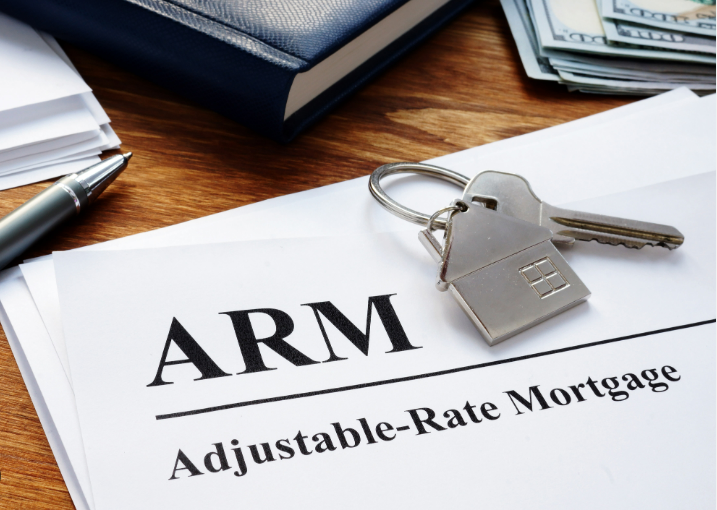All You Need to Know about Adjustable-rate Mortgages

When you obtain a mortgage, you have the option to choose between a fixed interest rate and an adjustable interest rate. Fixed-rate mortgages maintain the same rate and monthly payment throughout the loan term. In contrast, adjustable-rate mortgages (ARMs) feature an initial fixed-rate period, after which the interest rate can fluctuate, affecting your monthly payments. Typically, ARM rates start lower than fixed-rate mortgages but may increase after the introductory period ends.
Here’s what you need to know about ARMs: their structure, functionality, and the scenarios in which they might be beneficial.
What is an adjustable-rate mortgage (ARM)?
An adjustable-rate mortgage (ARM) is a home loan that starts with a low, fixed interest rate for a few years. After this initial period, the interest rate resets at regular intervals, causing monthly payments to fluctuate.
Generally, the initial rate on an ARM is lower than that of a comparable fixed-rate mortgage. Once the fixed-rate period ends, interest rates — and consequently your monthly payments — can increase or decrease.
Interest rates are unpredictable, though they’ve tended to fluctuate in multi-year cycles. During periods of higher rates, ARMs can help you save money early in your loan by locking in a lower initial rate. However, be aware that after the introductory period, the rate and your monthly payment may rise.
The initial interest rate on an ARM is sometimes called a “teaser” rate, and ARMs are often referred to as “teaser” loans. While generally similar, there can be a difference between a standard ARM and a riskier teaser loan, which offers an extremely low upfront rate followed by a significant rate increase.
Fixed-rate vs. adjustable-rate mortgages
The difference between fixed-rate and adjustable-rate mortgages (ARMs) is straightforward: Fixed-rate mortgages maintain the same interest rate for the entire loan term, while ARMs have a rate that fluctuates after an initial fixed period. Both types of loans function similarly in that you make monthly payments covering principal and interest, and sometimes homeowners insurance and property taxes.
“Deciding between a fixed-rate mortgage and an ARM is about choosing stability or flexibility,” says Linda Bell, principal writer for Bankrate’s Home Lending team. “With a fixed-rate mortgage, you get a consistent interest rate and predictable monthly payments. In contrast, an ARM offers a lower initial rate, which can mean lower payments early on. However, as market rates change, you need to be prepared for potential increases in your payments down the road.”
How does an adjustable-rate mortgage work?
ARMs consist of a few key components:
- Fixed period: This is the initial period with a low, fixed introductory rate, lasting from three to 10 years, depending on the loan. In an ARM’s naming convention, this is represented by the first number (e.g., the “7” in “7/1”).
- Adjustable period: After the fixed period ends, the adjustable period begins and continues until you sell, refinance, or pay off the loan.
- Rate of adjustment: ARMs adjust every six months to a year. This is indicated by the second number in the name (e.g., the “1” in “7/1” or the “6” in “5/6”). Variations exist, such as a 5/5 ARM, which adjusts every five years.
What are ARM rate caps?
ARMs include rate caps to protect you from steep increases in monthly payments. These caps limit how much rates and payments can change.
- Periodic rate cap: Limits the amount the interest rate can change from one year to the next.
- Lifetime rate cap: Limits the total amount the interest rate can increase over the life of the loan.
- Payment cap: Limits the dollar amount that monthly payments can increase over the life of the loan, rather than limiting the rate change in percentage points.
Adjustable-rate mortgage example
Imagine you took out a 30-year 5/1 ARM for $350,000 with an introductory rate of 6.65 percent (the average rate at the time of writing). Here’s a potential payment schedule, assuming interest rates increase annually by 0.25 percent. The ARM has a lifetime cap of 12 percent.
Types of ARMs

ARMs are typically 30-year mortgages, but the duration of the fixed-rate period and the frequency of rate adjustments during the variable-rate period can vary significantly. Here are some common loan terms:
- 3/6 and 3/1 ARMs: These have a fixed introductory rate for the first three years. After that, the rate adjusts for the remaining 27 years. A 3/6 ARM adjusts every six months, whereas a 3/1 ARM adjusts annually.
- 5/6 and 5/1 ARMs: These offer a fixed intro rate for the first five years, followed by an adjustable rate for the remaining 25 years. A 5/6 ARM adjusts every six months, and a 5/1 ARM adjusts annually.
- 7/6 and 7/1 ARMs: These provide a fixed intro rate for the first seven years, then switch to an adjustable rate for the remaining 23 years. A 7/6 ARM adjusts every six months, and a 7/1 ARM adjusts annually.
- 10/6 and 10/1 ARMs: These come with a fixed intro rate for the first 10 years, followed by an adjustable rate for the remaining 20 years. A 10/6 ARM adjusts every six months, and a 10/1 ARM adjusts annually.
In addition to these typical loan terms, there are three main types of ARMs: hybrid, interest-only, and payment-option.
Hybrid ARM
A hybrid ARM is a common type of adjustable-rate mortgage. It begins with a fixed interest rate for an initial period, typically ranging from three to ten years. After this fixed-rate period, the interest rate adjusts up or down according to a preset schedule, such as annually.
Interest-only ARM
Interest-only ARMs are adjustable-rate mortgages where the borrower pays only the interest, without paying down the principal, for a specified period. Once this interest-only period ends, the borrower begins making full principal and interest payments.
The interest-only period can last anywhere from a few months to several years. During this time, the monthly payments are lower because they cover only the interest. However, the borrower does not build any equity in the home unless the property’s value appreciates.
Payment-option ARM
With a payment-option ARM, borrowers have the flexibility to choose their payment structure and schedule. Options include making interest-only payments, selecting a 15-, 30-, or 40-year term, or any other payment that meets or exceeds the minimum payment. The minimum payment is typically based on a 30-year amortization with the loan’s initial rate.
However, a payment-option ARM can lead to negative amortization, where the loan balance increases because the payments do not cover the interest. If the balance rises too much, the lender may recast the loan, requiring significantly larger and potentially unaffordable payments.
Is an adjustable-rate mortgage right for you?
There are several reasons why an ARM might be suitable for your situation:
- Initial lower monthly payments: An ARM offers a lower initial interest rate, resulting in lower monthly payments early on. This can free up funds to allocate towards paying down the principal or other financial priorities.
- Increased budget flexibility: Lower initial payments provide flexibility to adjust payments based on your financial situation. You can choose to pay more when finances permit and scale back when needed for other expenses.
- Short-term homeownership plans: ARMs are advantageous if you plan to sell or refinance your home within a few years. You can benefit from the lower introductory rate and potentially avoid rate adjustments by ending the mortgage before the adjustable period begins.
However, if you intend to stay in your home for the long term, an ARM carries risks. Once the initial fixed-rate period ends, your mortgage payments could increase significantly with market interest rate changes. For those purchasing a permanent residence, carefully consider whether an ARM aligns with your financial goals and stability.
MORE FROM discountdiscover.com












